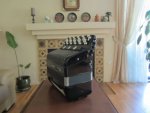Acon
Active member
- Joined
- Jan 20, 2016
- Messages
- 105
- Reaction score
- 1
Hello everybody, my name is Acon Cheng and I live in Australia. I use
a C-system chromatic button accordion PIGINI B43 convertor model.
Now I have a chance to buy a PIGINI Ellegaard Special convertor from
someone owns it. Has anyone familiar with this series? It’s specially
made to pay the tribute to Mogens Ellegaard, who made great contribution
to the modern accordion design and education.
There are several different ES models there and this one I want to buy is
a full range model with 4 reeds/2 cassotos/hand-made reeds on the right
hand side. The only thing concerns me is that there’s no register on the
left hand side (only the convertor switch).
The seller told me it’s lack of register is to produce stronger bass like the
Jupiter brand from Russia. Don’t know if this is true, but I did saw some
Russian masters playing their B-system Jupiter bayans, and those instrument
dont have any left hand register.
So I want to know are those registers on the left side important (for the
free bass)?
Ive attached some photos of this PIGINI Ellegaard Special accordion. The
seller said its 15kg and made in 2007, and he said its one of the only six
same models in the world.
These pictures are interesting because Ive saw some videos about the ES
series and they dont have the PIGINI logo on the instrument:
Ellegaard Special 55/B
The one in the video is 25 years old. After gathering some information
about this series I found this German link:
www.pigini.homepage.t-online.de
Google translated the description as below:
PIGINI ELLEGAARD special models were named after the Danish accordion virtuoso Mogens Ellegaard and educators. Ellegaard had a significant contribution to the development of PIGINI Convertormechanik and at that time also get the first PIGINI SIRIUS model. The PIGINI ELLEGAARD special models were produced as a piano and button Convertorakkordeons in the years from about 1970 to 1985. The company name PIGINI is not to be found on these models, but ELLEGAARD special and the model name. The owners of these accordions appreciate the very full and rich bass sound with a very broad base, the one et al achieved through a design with angular bass sound post. The modern lightweight construction at the time was not yet at the present level, so the musicians have to take on these models a significantly higher weight than comparable PIGINI instruments of the current model series in buying.
According to the translation the ES series is old and they are heavier than
normal modern PIGINI correspondents. But the one I want to buy looks more
modern. This also confuse me because the old one in the video has many left
registers but this one doesnt!
Hope someone can give me some ideas about these question.
Thanks.
a C-system chromatic button accordion PIGINI B43 convertor model.
Now I have a chance to buy a PIGINI Ellegaard Special convertor from
someone owns it. Has anyone familiar with this series? It’s specially
made to pay the tribute to Mogens Ellegaard, who made great contribution
to the modern accordion design and education.
There are several different ES models there and this one I want to buy is
a full range model with 4 reeds/2 cassotos/hand-made reeds on the right
hand side. The only thing concerns me is that there’s no register on the
left hand side (only the convertor switch).
The seller told me it’s lack of register is to produce stronger bass like the
Jupiter brand from Russia. Don’t know if this is true, but I did saw some
Russian masters playing their B-system Jupiter bayans, and those instrument
dont have any left hand register.
So I want to know are those registers on the left side important (for the
free bass)?
Ive attached some photos of this PIGINI Ellegaard Special accordion. The
seller said its 15kg and made in 2007, and he said its one of the only six
same models in the world.
These pictures are interesting because Ive saw some videos about the ES
series and they dont have the PIGINI logo on the instrument:
Ellegaard Special 55/B
The one in the video is 25 years old. After gathering some information
about this series I found this German link:
www.pigini.homepage.t-online.de
Google translated the description as below:
PIGINI ELLEGAARD special models were named after the Danish accordion virtuoso Mogens Ellegaard and educators. Ellegaard had a significant contribution to the development of PIGINI Convertormechanik and at that time also get the first PIGINI SIRIUS model. The PIGINI ELLEGAARD special models were produced as a piano and button Convertorakkordeons in the years from about 1970 to 1985. The company name PIGINI is not to be found on these models, but ELLEGAARD special and the model name. The owners of these accordions appreciate the very full and rich bass sound with a very broad base, the one et al achieved through a design with angular bass sound post. The modern lightweight construction at the time was not yet at the present level, so the musicians have to take on these models a significantly higher weight than comparable PIGINI instruments of the current model series in buying.
According to the translation the ES series is old and they are heavier than
normal modern PIGINI correspondents. But the one I want to buy looks more
modern. This also confuse me because the old one in the video has many left
registers but this one doesnt!
Hope someone can give me some ideas about these question.
Thanks.




